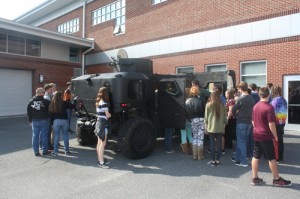
SNOW HILL — Students at the Worcester Technical High School (WTHS) got a glimpse of where the field of engineering could lead them when Pocomoke-based Hardwire LLC visited with one of its prototype, military-inspired vehicles.
Hardwire has been working on developing high-concept technology for years, often for military application. The tactical vehicle brought to WTHS Tuesday is currently undergoing testing with the U.S. Army and could be a more mobile, efficient and lighter alternative for protecting troops from explosives in combat zones.
In developing the vehicle, Hardwire began with a problem statement, just like students at WTHS begin their own projects, said engineer Rob Cosgriff. In this case, the problem was that soldiers are being killed or injured specifically by under-vehicle blasts. And the solutions in the field so far are less than perfect.
“The solutions that have been presented to date, other trucks and vehicles, they’re too heavy, they’re too big to drive in tight spaces, they’re too loud and they can’t be lifted by helicopters,” Cosgriff said.
Hardwire tackled the problems one at a time using the same kind of reasoning that all engineers, and pre-engineers like those at WTHS, are taught to use.
“Let’s think about what that solution looks like, first of all, and then paint that vision and then start to fill in the details,” Cosgriff said. “The way I would look at it from a problem perspective is: you put the vision out there and then start to break it down into smaller and smaller solutions.”
The company took a three-angled approach and searched for solutions to what they saw as the three primary issues of survivability, mobility and energy. Survivability could mean adding more armor, using new materials or changing the vehicle design to in some better way protect from under-vehicle blasts. That part by itself isn’t too difficult, according to Cosgriff, who pointed to the large armored trucks that the military currently uses, some of which can weigh up to 45,000 pounds. That does make mobility an issue, however.
“It’s like driving a dump truck around. So you can imagine the soldiers doing their jobs … it’s very tough driving a dump truck around and getting into tight spaces and doing what they need to do,” he said.
Those heavy trucks are also extremely slow, which is not ideal for combat situations.
“For our military guys that are out in the field somewhere, speed is everything, speed is a weapon. If you’ve got to go slow, you’re a target,” he said.
So the first two solutions had to synchronize. Hardwire studied the suspensions of Baja truck racing to come up with inspiration for how they could combine mobility and defense. The third problem concerned energy and efficiency and also had to fit in with the first two. So with the new concept vehicle, Hardwire elected to go with an electric drive power system that could be used to power equipment as well as propulsion and would keep everything quiet so as not to draw attention.
“By making it an electric drive vehicle, we convert all of the mechanical energy, which can be used for propulsion, turning your wheels, or it can be used for other stuff,” he said.
What was left when all three problems were solved was shown to students this week.
It’s a prime example of giving kids a practical visual for what they’re learning in the classroom, said Hardwire engineer Justin Gordon. That is especially noteworthy for Worcester, which still struggles with a reputation for not being able to provide enough Science, Technology, Engineering and Math (STEM) jobs, meaning that when students graduate and want to enter an engineering field they will often have to leave the Eastern Shore.
That trend could be changing and Gordon, a Snow Hill High School graduate who returned to Worcester County after college in Florida, is a prime example of that. He was able to find work with Hardwire after interning with them during college. After seeing the positive reactions of students who were able to actually see and touch a prototype armored vehicle, Gordon said that he wished there had been more of that kind of real-world interaction with schools when he was a student.
“Sometimes in school you don’t get to see the end result of what comes from these design projects and stuff like that,” he said. “This visit kind of lets these guys see a finalized vehicle and seeing where a prototype can actually lead.”
Gordon was optimistic about the shore shedding that reputation of not having STEM careers available soon. WTHS could play a role in that effort. Principal Caroline Bloxom said this week that the school will look to partner with more local businesses that can show students where engineering can lead.
“We are in communication with some other businesses to get them to come to our school with the various projects they’re actually working on,” she said.
